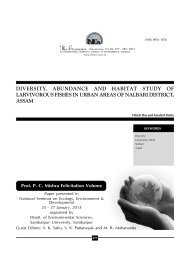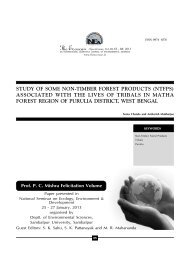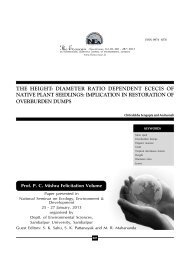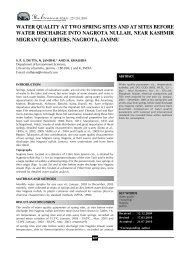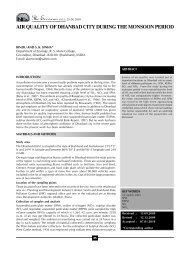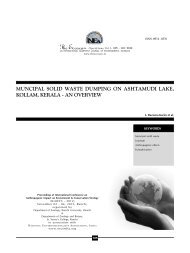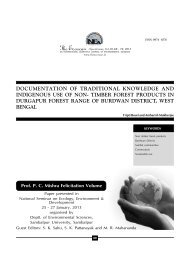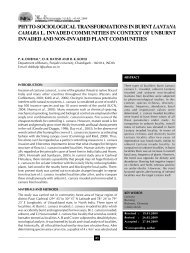J. Seetharamulu.pmd
J. Seetharamulu.pmd
J. Seetharamulu.pmd
Create successful ePaper yourself
Turn your PDF publications into a flip-book with our unique Google optimized e-Paper software.
NSave Nature to Survive<br />
QUARTERLY<br />
6(1&2): 93-97, 2012<br />
93<br />
www.theecoscan.in<br />
EFFECT OF MEDICINAL PLANTS AND BIOFUNGICIDES ON<br />
DEFENSE ENZYME LEVELS AND DISEASE CONTROL IN<br />
MULBERRY<br />
J. SEETHARAMULU*, J. UMAMAHESHWARI 1 , A. SREERAMULU 1 , A. K. GOEL AND P. J. RAJU<br />
Andhra Pradesh State Sericulture Research and Development Institute,<br />
Kirikera - 515 211, Hindupur, Andhra Pradesh, INDIA<br />
1 Department of Biochemistry, Sri Krishnadevaraya University,<br />
Anantapur - 515 003, Andhra Pradesh, INDIA<br />
e-mail: sithara_jolapuram@rediffmail.com<br />
INTRODUCTION<br />
Mulberry (Morus alba L.) is one of the most important commercial crops grown<br />
extensively as food plant for the silkworm (Bombyx mori L.). Being a vegetatively<br />
propagated perennial crop, initial establishment of mulberry is affected by many<br />
soil borne fungal diseases namely stem canker and die-back caused by<br />
Botryodiplodia theobromae, cutting rot caused by Fusarium solani and collar rot<br />
caused by Phoma sorghina, Phoma mororum and Sclerotium rolfsii (Gupta et al.,<br />
1997) and cutting die-back caused by Alternaria tenuissima (Seetha et al., 2004<br />
& 2008). These diseases affect almost all the mulberry varieties cultivated in India.<br />
Chemical fungicides have been suggested for the effective control of mulberry<br />
diseases, but these chemicals could not get wide acceptance among sericulturists<br />
due to their prohibitive cost, possible toxicity to silkworm and various hazards to<br />
mankind and environment. The use of plant products and microbial agents for<br />
controlling the plant diseases is generally regarded as a potential and safe alternative<br />
to chemical fungicides. The plant kingdom represents an enormous reservoir of<br />
potential chemical compounds and also leads to an increase in the enzyme<br />
activity viz. peroxidase and polyphenol oxidase. Similarly the chemical<br />
compounds like phenols, alkaloids and primary metabolites also increased which<br />
it increases the resistance in plants. In the present study some efforts have been<br />
made in controlling the pathogens at nursery stage with an integration of plant<br />
extracts and bio-control agents.<br />
MATERIALS AND METHODS<br />
In vitro studies<br />
Medicinal plant extracts were tested against the mycelial growth of the pathogenic<br />
fungi viz. A. tenuissima and F. solani through poisoned food technique (McCallan,<br />
1947) under in vitro conditions. The plant extracts were prepared according to<br />
the method of Awuah, 1989. The results were expressed in terms of per cent<br />
inhibition of mycelium over control.<br />
The fungal antagonists viz, T. viride, T. harzianum and T. pseudokoningii and the<br />
bacterial antagonist P. fluorescens were tested against the A. tenuissima and F.<br />
solani by Dual culture technique (Hung and Hoes, 1976).<br />
In vivo studies<br />
To test the efficacy of promising plant extracts and bio-fungicides against the<br />
pathogenic fungi, five treatments with three bio-fungicides {T. viride (T 1 ), T.<br />
harzianum (T 2 ) and P. fluorescens (T 3 )}, two plants extracts {L. camara (T 4 ) P.<br />
juliflora (T 5 )} and one chemical fungicide (T 6 ) (Mancozeb) were used for conducting<br />
ABSTRACT<br />
Medicinal plant extracts along with biofungicides<br />
were tested under in vitro to control<br />
the Fusarium solani and Alternaria tenuissima,<br />
the incitants of root rot and die-back diseases<br />
of mulberry. Plant extract of Prosopis juliflora<br />
showed maximum inhibition on the mycelial<br />
growth (above 80.0%) followed by L. camara<br />
(above 66.0%). Among the antagonists<br />
Pseudomonas fluorescens and Trichoderma<br />
viride showed maximum inhibition on the<br />
mycelial growth of both pathogenic fungi. The<br />
promising plant extracts (P. juliflora and L.<br />
camara) and antagonists (P. fluorescens and T.<br />
viride) were then tested against both the<br />
pathogenic fungi under in vivo along with<br />
popular chemical Mancozeb. Maximum<br />
survival percentage of mulberry cuttings was<br />
recorded in the treatment with T. viride and P.<br />
fluorescens (above 90%) followed by T.<br />
harzianum (above 80%) against both the<br />
pathogens. In case of plant extracts, P. juliflora<br />
recorded higher survival (above 55%) followed<br />
by L. camara (above 50%). Mancozeb recorded<br />
55 % survival. Whereas in control the survival<br />
was recorded 10 - 15% only. Alterations in<br />
the enzymatic activities due to infection of<br />
mulberry stem with A. tenuissima and F. solani<br />
were also evident.<br />
KEY WORDS<br />
Antagonists, Alternaria tenuissima<br />
Defence enzymes, Fusarium solani<br />
Mulberry nursery, Plant extracts<br />
Survivability<br />
Received : 17.11.2011<br />
Revised : 22.02.2012<br />
Accepted : 24.04.2012<br />
*Corresponding author
J. SEETHARAMULU et al.,<br />
the experiment under controlled conditions. Control pots<br />
were inoculated with the test fungi separately and left without<br />
treatment. All the treatments were given before planting the<br />
cutting in to the inoculated soil. The sterilized soil was used<br />
for inoculation.<br />
Inoculation<br />
The test fungi were grown in corn meal - sand medium for<br />
inoculation (Rangaswamy and Mahadevan, 2001). The 15<br />
days old culture incubated at 29 ± 1ºC of A. tenuissima and<br />
F. solani were used for inoculation of sterilized soil. The corn<br />
meal-sand culture of the A. tenuissima and F. solani was<br />
thoroughly mixed with sterilized soil separately at 10% level<br />
(w/w - 90g sterilized soil + 10g inoculum). Each of the test<br />
fungus was mixed with sterilized soil separately and poured<br />
in to polythene bags (1kg inoculated soil/bag). Later twenty<br />
cuttings were treated with each test bio-fungicide, plant<br />
products and Mancozeb separately and planted in the<br />
polythene bags (one cutting/bag). Twenty cuttings were<br />
maintained for each treatment and control. All the bags were<br />
watered on alternate days with sterilized water and kept in<br />
open condition.<br />
The cuttings were dipped in plant extracts of required<br />
concentration (L. camara at 100% and P. juliflora at 10%<br />
concentration) for half an hour and 100 mL of plant extract<br />
was added to the inoculated soil in the bag and planted the<br />
treated cuttings with plant extract. The talc based bio-fungicide<br />
was mixed with distilled water to form fine slurry and the<br />
cleaned mulberry cuttings were dipped in to the slurry for 30<br />
minutes and 10 g of bio-fungicide was added to each bag<br />
containing inoculated soil with test fungi and treated cuttings<br />
with bio-fungicide were planted in the bags. In case of chemical<br />
treatment the cuttings were dipped in 0.1% Mancozeb<br />
solution for 30 minutes and 100 ml of 0.1% Mancozeb<br />
solution is added to the inoculated bag and cuttings were<br />
planted. The disease index was observed and the survival<br />
percentage was calculated to each treatment and assessed<br />
their efficacy.<br />
Enzymatic studies<br />
The mulberry stem tissues from the all treatments and control<br />
bags were collected separately in to polythene bags at different<br />
intervals i.e. 15 th , 30 th , 45 th and 60 th day of plantation (Stage I,<br />
II, III and IV) and these samples were used for enzyme<br />
Table 1: Efficacy of plant extracts against the mycelial growth of A. tenuissima and F. solani under in vitro by poisoned food technique<br />
Botanical source A. tenuissima F. solani<br />
Mycelialgrowth (cm) Inhibition (%) Mycelialgrowth (cm) Inhibition (%)<br />
Prosopis juliflora, leaf 1.70 81.17 1.80 80.03<br />
Calotropis procera, leaf 3.80 57.80 3.60 60.03<br />
Annona squaimosa, seed 3.60 60.03 5.90 34.50<br />
Cassia occidentalis, leaf 7.00 22.27 7.60 15.60<br />
Ocimum sanctum, leaf 6.20 31.17 7.40 17.80<br />
Azadiracta indica , seed 3.40 62.30 6.90 23.40<br />
Eucalyptus globules, leaf 7.60 15.60 7.80 13.40<br />
Aloe vera, leaf 7.73 14.13 8.60 4.50<br />
Lantana camara, leaf 3.00 66.70 2.80 68.93<br />
Vinca rosea, leaf 7.90 12.27 4.10 54.50<br />
Mancozeb 0.40 95.56 0.60 93.33<br />
Control 9.00 — 9.00 —<br />
CD (P d” 0.05) 0.29 3.22 0.25 2.75<br />
94<br />
extraction. The small pieces (25g from each treatment and<br />
control) of the tissues were transferred to warring blender and<br />
added 100 mL of chilled Acetic acid-acetate buffer at pH 5.2<br />
blended for 10 minutes, filtered through two layers of<br />
cheesecloth and centrifuged at 2000 g at 35ºC for 20 minutes.<br />
The supernatant was collected in conical flask. The crude<br />
enzyme in the flask was used for the measurement of<br />
endoglucanase (β-1, 3-glucanase) activity. This enzyme extract<br />
was stored at 2-4ºC by adding a few drops of tolune for later<br />
use (Aneja, 2003). The activity of endoglucanase was<br />
quantified by CMC method (Ghosh, 1987) and the activities<br />
of polyphenol oxidase (PPO) and peroxidase (PEO) was<br />
determined by Fehrmann and Dimond (1967).<br />
RESULTS AND DISCUSSION<br />
In vitro studies<br />
Among all the plant extracts P. juliflora showed highest<br />
inhibition on both fungi (81.2 % over A. tenuissima and 80.0<br />
% over F. solani) and followed by L. camara (66.7 % over A.<br />
tenuissima and 68.9 % over F. solani). In the present study<br />
significant differences in inhibition of mycelial growth was<br />
observed in A. tenuissima and F. solani by the interaction with<br />
T. viride and P. fluorescens. These two antagonists showed<br />
high levels of inhibition (80-88 %) as shown in table 2, where<br />
as T. pseudokoningii and T. harzianum showed moderate<br />
level of inhibition against both pathogenic fungi.<br />
In vivo studies<br />
All the tested plant products and bio-fungicides showed<br />
inhibitory effect on the growth of F. solani and A. tenuissima.<br />
The maximum survival percentage was recorded in T. viride<br />
and P. fluorescens (above 90 %) followed by T. harzianum<br />
(80 %). Incase of the treatments with plant extracts, P. juliflora<br />
(above 55 %) showed higher survival percentage and followed<br />
by L. camara (above 50 %). Mancozeb recorded 55 %<br />
survivability. Percent improvement of survivability over control<br />
under disease stress conditions of F. solani was recorded 85.0<br />
%, 70.0 %, 80.0 %, 45.0 %, 50.0 % and 45.0 % in the<br />
treatments with T. viride, T. harzianum, P. fluorescens, L.<br />
camara, P. juliflora and Mancozeb respectively. In case of A.<br />
tenuissima inoculated bags the percent improvement of<br />
survivability over control was recorded higher with 75.0 %,<br />
70.0 %, 75.0 %, 35.0 %, 40.0 % and 40.0 %.
Units/mL<br />
Specific activity/mg protein<br />
Specific activity/mg protein<br />
120<br />
100<br />
80<br />
60<br />
40<br />
20<br />
0<br />
0.4<br />
0.35<br />
0.3<br />
0.25<br />
0.2<br />
0.15<br />
0.1<br />
0.05<br />
180<br />
160<br />
140<br />
120<br />
100<br />
80<br />
60<br />
40<br />
20<br />
0<br />
0<br />
I II III IV<br />
C I T.V P.F L.C P.J M<br />
Treatments<br />
I II III IV<br />
C I T.V P.F L.C P.J M<br />
Treatments<br />
I II III IV<br />
Endoglucanase<br />
Peroxidase<br />
Polyphenol oxidase<br />
C I T.V P.F L.C P.J M<br />
Treatments<br />
Figure 1: Effect of F. solani infection on the activity of defense<br />
enzymes of mulberry stem tissues at different stages of disease<br />
development under different treatments<br />
The present study disclose that, the plant extracts of P. juliflora<br />
and L. camara were found to be effective in inhibiting the<br />
growth of pathogenic fungi. The present findings are agreeing<br />
with the earlier reports of many researchers. Raghavendra et<br />
al., (2002) reported the fungi toxic properties of P. juliflora<br />
against eight species of Fusarium and one species of Alternaria.<br />
Antifungal properties of extracts of P. juliflora have also been<br />
reported by Muthulakshmi (1990) and Narasimhan et al.,<br />
(1991) against A. tenuissima. Ram and Thakore (2005) reported<br />
the extracts from L. camara were effective in inhibiting the<br />
growth of F. solani. In case of bio-fungicides P. fluorescens<br />
and T. viride were found to be effective in controlling F. solani<br />
95<br />
Table 2: Efficacy of antagonists against the mycelial growth of A.<br />
tenuissima and F. solani under in vitro conditions<br />
Name of the antagonist Inhibition of mycelial growth (%)<br />
A. tenuissima F. solani<br />
Trichoderma viride 87.7 88.9<br />
Trichoderma harzianum 64.4 68.9<br />
Trichoderma pseudokoningii 73.3 80.0<br />
Pseudomonas fluorescens 83.3 78.9<br />
Control 0.0 0.0<br />
C D (P d” 0.05) 2.61 2.66<br />
Units/mL<br />
Specific activity/mg protein<br />
Specific activity/mg protein<br />
0.4<br />
0.35<br />
0.3<br />
0.25<br />
0.2<br />
0.15<br />
0.1<br />
0.05<br />
180<br />
160<br />
140<br />
120<br />
100<br />
80<br />
60<br />
40<br />
20<br />
0<br />
120<br />
100<br />
80<br />
60<br />
40<br />
20<br />
0<br />
0<br />
EFFECT OF MEDICINAL PLANTS AND BIOFUNGICIDES<br />
I II III IV<br />
C I T.V P.F L.C P.J M<br />
Treatments<br />
I II III IV<br />
C I T.V P.F L.C P.J M<br />
Treatments<br />
I II III IV<br />
Endoglucanase<br />
Peroxidase<br />
Polyphenol oxidase<br />
C I T.V P.F L.C P.J M<br />
Treatments<br />
Figure 2: Effect of A. tenuissima infection on the activity of defense<br />
enzymes of mulberry stem tissues at different stages of disease development<br />
under different treatments<br />
and A. tenuissima. Philip et al., (1996) reported the<br />
antagonistic effect of a local isolate of T. harzianum against<br />
the mulberry root rot pathogen with 74 % protection to the<br />
mulberry plants. Dhoke (2005) reported the efficacy of<br />
fluorescent Pseudomonas isolates against some Fusarium<br />
species. Such effective inhibition of mycelial growth of F. solani
J. SEETHARAMULU et al.,<br />
Table 3: Efficacy of plant extracts and antagonistic fungi against the A. tenuissima and F. solani under simulated conditions (In vivo)<br />
Sl.No. Treatments No. of cuttings Soil inoculated with F. solani Soil inoculated with A. tenuissima<br />
planted No. of cuttings Survival Percent over No. of cuttings Survival Percent over<br />
survived % survived % control<br />
1 Trichoderma viride 20 19 95 + 85 18 90 + 75<br />
2 Trichoderma harzianum 20 16 80 + 70 17 85 + 70<br />
3 Pseudomonas fluorescens 20 18 90 + 80 18 90 + 75<br />
4 Lantana camara 20 11 55 + 45 10 50 + 35<br />
5 Prosopis juliflora 20 12 60 + 50 11 55 + 40<br />
6 Mancozeb 20 11 55 + 45 11 55 + 40<br />
7 Control 20 2 10 0 3 15 0<br />
+ = Increase over control ; Each value is an average of three replications<br />
by T. viride has been reported by Jha and Jalali (2006). Bohra<br />
et al., (2005) reported the treatment with Pseudomonas<br />
significantly reduces the disease severity of Fusarium wilt in<br />
the nursery. Mostapha et al., (2006) reported P. fluorescens<br />
have an excellent potential to be used as biocontol agents<br />
against mulberry root rot pathogens viz. B. theobromae, F.<br />
solani, F. oxysporum and R. solani. All these findings were<br />
agreeing with the present findings.<br />
It is finally reveals from the present research findings, the biofungicides<br />
viz, Trichoderma viride and Pseudomonas<br />
fluorescens and Prosopis juliflora (plant extract) were suggested<br />
as pre-plantation treatment for effective control of cutting rot<br />
and die-back diseases of mulberry nursery.<br />
Defense enzymes<br />
The endoglucanase (β-1, 3- glucanase) activity under disease<br />
stress conditions of F. solani was high in T (15.7 %, 39.5 %,<br />
1<br />
30.5 % and 21.9 % at 1, 2, 3 and 4 stages respectively than<br />
the control) and T (20.6%, 42.8%, 25.2% and 27.1% at stage<br />
2<br />
1, 2, 3 and 4 respectively than the control) treated stems than<br />
all other treatments and control. Infection had a pronounced<br />
effect on endoglucanase activity and steep increase up to 2nd<br />
stage of infection, later slight decrease in the enzyme activity<br />
was noticed (Fig. 1). In case of the disease stress conditions of<br />
A. tenuissima, endoglucanase activity in T and T was<br />
1 2<br />
recorded very high than the control and infected stem.<br />
Remaining treatments also showed higher enzyme activity than<br />
the control at all the stages. Infection had a pronounced effect<br />
on peroxidase activity under the disease stress conditions of<br />
F. solani and resulted in steep increase at various stages of<br />
disease development. The higher enzyme activity was noticed<br />
in the T and T treatments. The enzyme activity was recorded<br />
1 2<br />
high by 31.1 %, 38.7 %, 64.5 % and 63.5 % in T and 30.9 %,<br />
1<br />
69.0 %, 73.3 % and 68.9 % in T at 1 2 st , 2nd , 3rd and 4th stage<br />
respectively than the control. Whereas the enzyme activity<br />
under the disease stress conditions of A. tenuissima all the<br />
treatments showed increased activity over control. In the<br />
treatments with bio-fungicide (T & T ) the enzyme activity was<br />
1 2<br />
found very high at all stages than the control.<br />
The activity of polyphenol oxidase under the disease stress of<br />
both the fungi showed gradual increase in all the treatments.<br />
T & T treatments recorded high enzyme activity. In the<br />
1 2<br />
treatments T and T also showed increased enzyme activity<br />
3 4<br />
over control. In case of A. tenuissima infection the enzyme<br />
activity in all the treated tissues was increased according to<br />
the stage than the control (Fig. 2). In case of T and T treatments<br />
1 2<br />
the enzyme activity was recorded higher than the infected<br />
stem tissues.<br />
96<br />
In the present study it was noticed that the activities of β-1, 3glucanase,<br />
PEO and PPO were increased in the plants treated<br />
with biofungicides and plant products than the control. Similar<br />
results were also found by many other researchers. According<br />
to Karthikeyan et al. (2005) the enzymes viz, chitinase, β-1, 3glucanase,<br />
peroxidase and polyphenol oxidase were induced<br />
in the A. palandui inoculated plants, whereas an additional<br />
increase in the synthesis of these enzymes was observed in<br />
the P. fluorescens Pf pretreated plants challenge-inoculated<br />
1<br />
with A. palandui.<br />
Increased PEO and PPO activity is a general phenomenon in<br />
the inoculated plants. According to Van Loon et al., 1998<br />
induction of defense enzymes makes the plant resistant to<br />
pathogen invasion. These results agreeing with the findings of<br />
Gupta et al. (2007) found higher amount of oxidative enzymes<br />
viz, catalase, poly phenol oxydase and peroxidase were<br />
present in anthracnose diseased leaves of French bean than<br />
healthy ones and resistant varieties showed higher enzyme<br />
activity than their susceptible counterparts. According to<br />
Kloepper et al. (1996) induction of systemic resistance may<br />
involve activation of multiple potential defense mechanisms,<br />
including increased activity of β- 1, 3- glucanases, peroxidase.<br />
Induced disease resistance has been demonstrated in a number<br />
of plants – pathogen interactions by Sticher et al. (1997).<br />
Alterations in the enzymatic activities due to infection of<br />
mulberry stem with Alternaria tenuissima and Fusarium solani<br />
were also evident. The activities of defence enzymes viz.<br />
endoglucanase, peroxidase and polyphenol oxidase were<br />
increased in the plants treated with bio-fungicides and plant<br />
products under disease stress conditions of both the<br />
pathogenic fungi at various stages of disease development.<br />
Further, the increased enzyme activities were observed in the<br />
mulberry stem tissues treated with Trichoderma viride and<br />
Pseudomonas fluorescens as compared to control and also in<br />
other treatments. Whereas in chemical treatment not much<br />
difference in the enzyme activity was observed when compared<br />
with corresponding healthy stem tissues. Prabhu et al. (2004)<br />
also reported that, there was an increase in the enzyme activity<br />
viz., peroxidase and polyphenol oxidase, when the plants<br />
were treated with plant products. Similarly the chemical<br />
compounds like phenols, alkaloids and primary metabolites<br />
also increased which it increases the resistance in plants. In<br />
case of diseases, the plant extracts may lock the susceptible<br />
sites that prevent the entry of pathogen into the plant. Perez et<br />
al. (2002) reported T. harzianum produce some fungal cell<br />
wall hydrolyzing enzymes within their biocontrol mechanism.<br />
According to Karthikeyan et al. (2005) the activity of β-1, 3glucanase<br />
was greatly induced in Pf treated plants as<br />
1
compared with controls and also showed significant increase<br />
in the levels of the defense enzymes in comparison to the<br />
plants challenged with the pathogen. According to<br />
Schlumbaum et al. (1986) and Velazhahan et al. (2003)<br />
chitinase and β-1, 3-glucanase have the potential to hydrolyze<br />
chitin and β-1, 3-glucan respectively, the major components<br />
of fungal cell walls, leading to direct inhibition growth of several<br />
fungi. The studies indicate that, the plant products and biofungicides<br />
are very much effective in controlling the disease<br />
and also facilitating as plant growth promoter by triggering the<br />
defense mechanism.<br />
REFERENCES<br />
Awuah, R.T. 1989. Fungi toxic effects of extracts from some West<br />
African plants. Ann. Appl. Biol. 115: 451-453.<br />
Bohra, S., Mathur, N. and Vyas, A. 2005. Biocontrol of Fusarium<br />
wilt by plant growth promoting rhizobacteria. J. Mycol. Pl. Pathol.<br />
35(3): 537.<br />
Dhoke, P.K. 2005. Efficacy of fluorescent Pseudomonas isolates against<br />
Fusarium oxysporum f. sp ciceri. Natl. sym: “Crop disease management<br />
in Dry land Agriculture”. Marathwada Agriculture University,<br />
Parbhani, January 12–14.<br />
Gupta, S., Kalha, C. S. and Gupta, V. 2007. Role of oxidative enzymes<br />
and biochemical constituents of French bean in imparting resistance<br />
against bean anthracnose. 2nd Asian Congress of Micology and Plant<br />
pathology. December 19-22, 2007. Organised by Indian Society of of<br />
Micology and Plant pathology, Osmania University, Hyderabad.<br />
(Abs.). p. 279.<br />
Gupta, V. P., Govindaiah. and Raju, H. V. 1997. Diseases and<br />
associated fungal pathogens of Mulberry nurseries. Indian Phytopath.<br />
50: 402 - 407.<br />
Hung, H. C. and Hoes, J. A. 1976. Penetration and infection of<br />
Sclerotinia sclerotiorum by Coniothyrium minitans. Can. J. Bot. 54:<br />
406-410<br />
Jha, P. K. and Jalali, B. L. 2006. The bacterial soft rots of certain<br />
vegeTables-II: pectinase, the cytolytic enzyme produced by Bacillus<br />
carotovorus and certain other soft rot organisms. Tech. Bull. Vt. Agr.<br />
Exp. Sta. 147: 283-360.<br />
Karthikeyan, M., Jayakumar, V., Radhika, K., Bhaskaran, R.,<br />
Velazhahan, R. and Alice, D. 2005. Induction of resistance in host<br />
against the infection of leaf blight pathogen (Alternaria palandui) in<br />
onion (Allium cepa Var aggregatum). Indian J. of Biochem. and<br />
Biophysics., December 2005, pp. 371-377.<br />
Kloepper, J. W., Zehnder, G. W., Tuzun, S., Murphy, J. F., Wei, G.,<br />
Yao, C. and Raupach G. 1996. Toward agricultural implementation<br />
of PGPR – mediated induced systemic resistance against crop pests.<br />
In: Advances in Biological Control of plant Diseases (Eds. T. Wenhua,<br />
R.J. Cook and A. Rovira), China Agricultural University Press, Beijing,<br />
China. pp. 165-174.<br />
97<br />
EFFECT OF MEDICINAL PLANTS AND BIOFUNGICIDES<br />
McCallan, S. E. A. 1947. Bioassay of Agricultural fungicides, Agri<br />
chemicals. 2(9): 31 - 34.<br />
Mostapha, N. K., Esmaeil, K. and Afsaneh, M. 2006. Biological<br />
control of root rot pathogens in mulberry by antagonistic Bacteria.<br />
Sericologia. 46(2): 149-159.<br />
Muthulakshmi, P. 1990. Studies on fruit rot of Chillies (Capsicum<br />
annum L.) caused by Alternaria tenuis Nees. M.Sc (Ag) Thesis, Tamil<br />
Nadu Agricultural University, Coimbatore, India.<br />
Narasimhan,V., Senthilnathan, V. and Vijayan, M. 1991. Efficacy of<br />
botanical Pesticides on two fungal pathogens of vegetables. Indian<br />
Phytopath., Suppl. issue of vol. 45: XCIX (Abs.).<br />
Perez, L. M., Besoain, X., Reyes, M., Parado, G. and Montealegre, J.<br />
2002. The expression of extra cellular fungal cell wall hydrolytic<br />
enzymes in different Trichoderma harzianum isolates correlate with<br />
their ability to control Pyrenochaeta lycopersici. Biological Research.<br />
35: 401-410.<br />
Philip, T., Sharma, D.D. and Govindaiah 1996. Biological control of<br />
mulberry root rot disease. Indian Silk., 34(1): 6 - 8.<br />
Prabhu, M., Mayavel, A. and Natarajan, S. 2004. Eco friendly plant<br />
disease management in vegetables by using botanicals. In: Natl. Sym.<br />
on ‘Recent trends in applied Biology’ (Abs.). Jointly organized by<br />
Avinashilingam Institute for Home science and Higher education for<br />
Women-Deemed University, Coimbatore and Regional Sericultural<br />
Research Station, Central Silk Board, Salem. January 28 – 29.<br />
Raghavendra, M. P., Satish, S. and Raveesha, K. A. 2002. Prosopis<br />
juliflora Swartz: A potential plant for the management of fungal diseases<br />
of crops. In: Asian Cong. Mycol. Pl. Pathol., Indian Soc. Mycol. Pl.<br />
Pathol. University of Mysore (Abstracts) October 1-4. p.136.<br />
Ram, J. and Thakore, B. B. L. 2005. Management of storage rot of<br />
ginger using plant extracts and bio-control agent in southern Rajasthan.<br />
J. Mycol. Pl. Pathol. 35(3): 539.<br />
Rangaswamy, G. and Mahadevan, A. 2001. Diseases of crop plants<br />
in India (Fourth Edition), P H I PVT Ltd, New Delhi, pp. 536.<br />
Schlumbaum, A., Mauch, F., Vogeli, U. and Boller T. 1986. Nature.<br />
324: 365-367.<br />
Seetha, R. J., Raja Gopal Reddy, C. and Ramanjaneyulu, R. 2008.<br />
Incidence of Alternaria tenuissima on the stem cuttings during its<br />
development as sapling. Indian J. Mycol. Plant Pathol. 38(1): 130-<br />
131<br />
Seetha, R. J., Rajagopal Reddy, C. and Ramanjaneyulu, R. 2004.<br />
Nursery level incidence of A. tenuissima on stem cuttings of mulberry<br />
(Morus sp.) In: “Natl sym. on recent trends in plant sciences and 27th All India Botanical Conference”, October 29-31, 2004. Department<br />
of Botany, S.K. University, Anantapur, A. P, p.34<br />
Sticher, L., Mauch-Mani, B. and Metraux J. P. 1997. Annu Rev<br />
Phytopathol. 35: 235-270.<br />
Van Loon, L. C., Bakker, P. A. H. M. and Pieterse, C. M. J. 1998.<br />
Annu Rev Phytopathol. 36:453-483.<br />
Velazhahan, R., Jayaraj, J., Liang, G. H. and Muthukrishnan, S. 2003.<br />
Biol. Plant. 46: 29-33.





